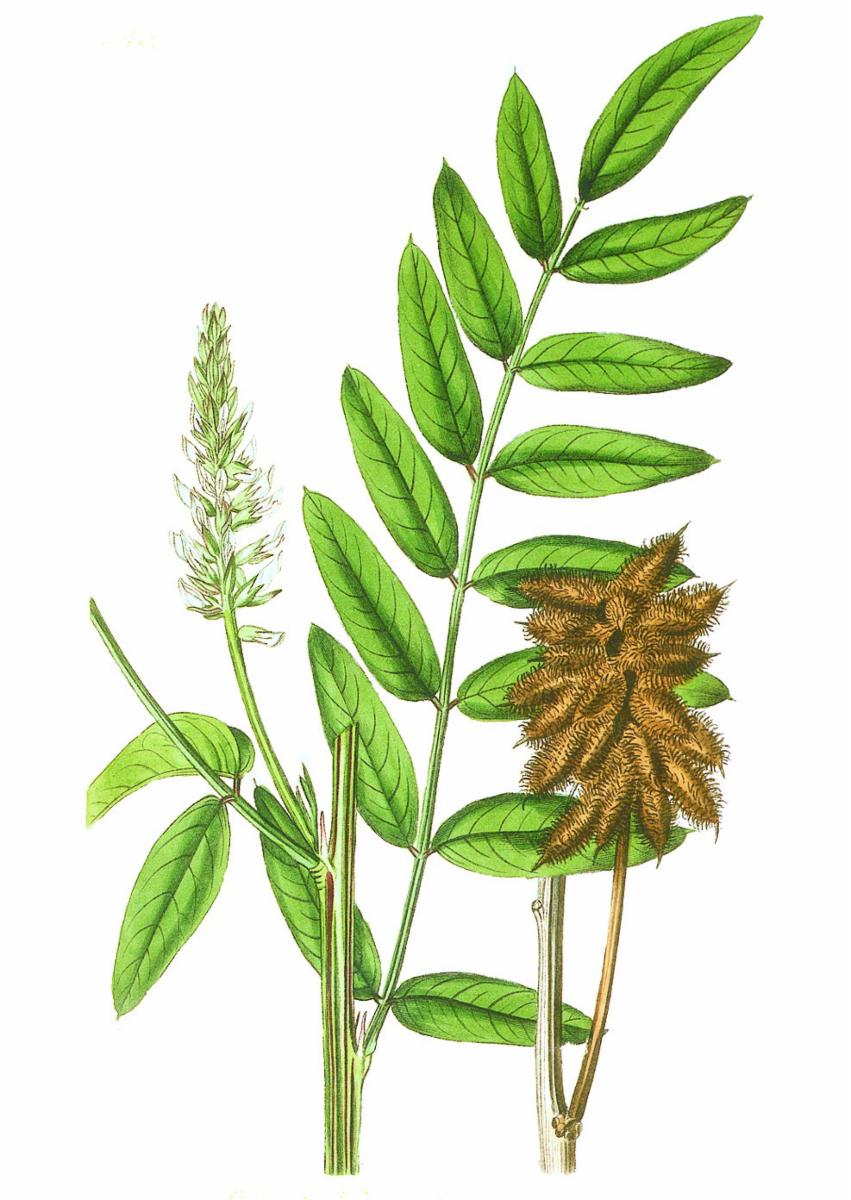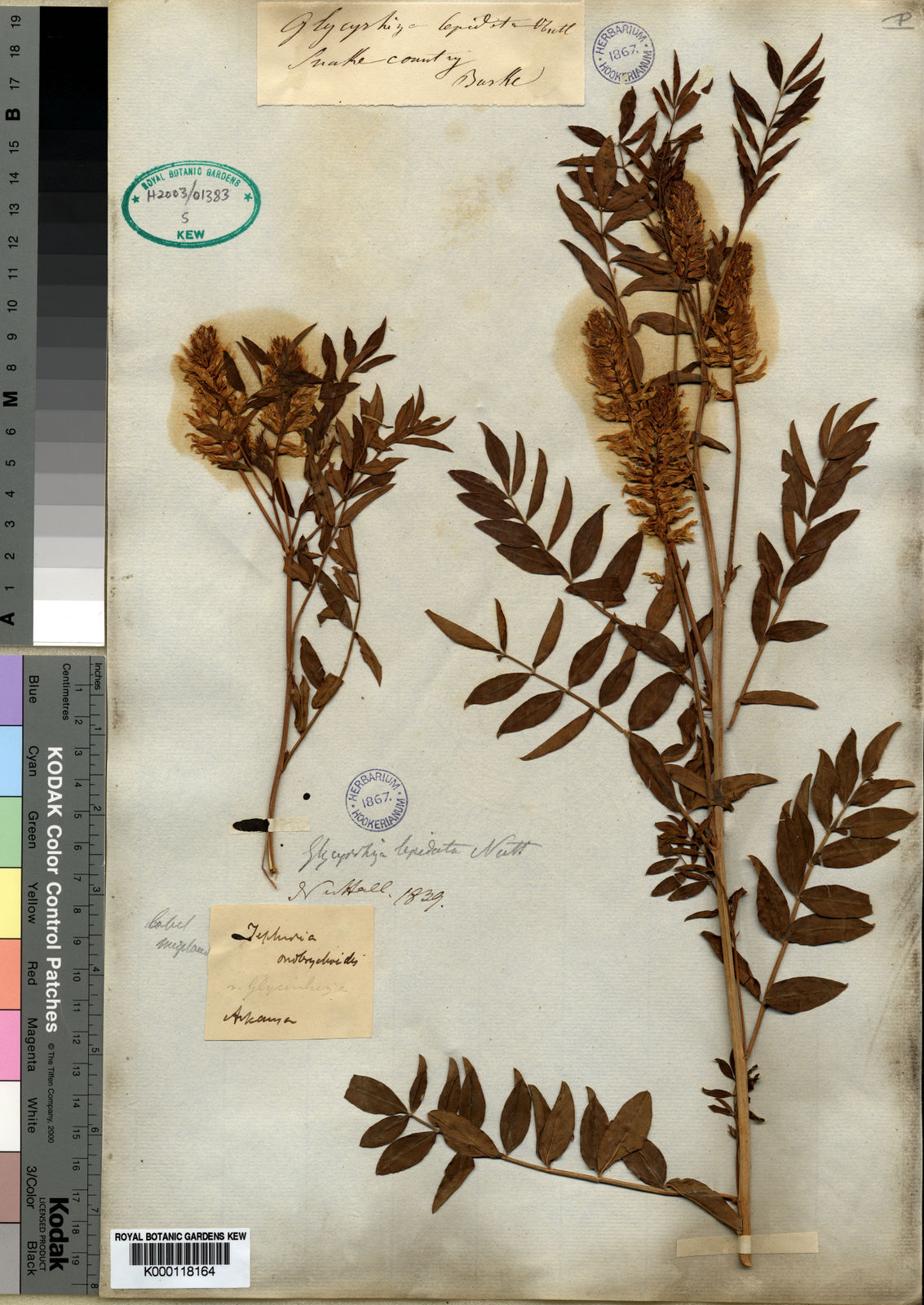American Licorice
glycyrrhiza lepidota
Also known as: ["Wild Licorice","Prickly Licorice"]
Overview
A perennial legume native to North America, known for its sweet-tasting roots and compound leaves with spiny stipules.
Benefits & Perks
["medicinal use","wildlife attractant (bees, butterflies, birds)","drought tolerant"]
Botanical Classification
| Phylum: | Magnoliophyta |
| Class: | Magnoliopsida |
| Order: | Fabales |
| Family: | Fabaceae |
| Genus: | Glycyrrhiza |
| Botanical Name: | Glycyrrhiza lepidota |
Plant Characteristics
Basic Information
- Category: Herbs & Weeds
- Suitable Location: open fields, meadows, or garden borders
- Suitable For:
- Is Weed: No
- Allergenicity: low
Environmental Needs
- Climate: {"temperatureRange":"–40–40°C"}
- Hardiness: {"zones":"3–9"}
- Misting: rarely required
- Drainage: Moderate to fast-draining. Avoid waterlogged conditions.
- Soil Type: Adaptable to various soils but prefers loamy, well-draining soil with organic matter.
Maintenance Level
- Maintenance Level: low
- Toughness Level: high
- Pruning Frequency: As needed, typically after flowering or in late winter/early spring.
- Pruning Intensity: Light to moderate. Remove only dead, diseased, or overcrowded stems.
Care Details
Ideal Sunlight Coverage:
Full sun to partial shade (6–8 hours of direct sunlight daily). Tolerates some shade but may produce fewer flowers.
Sunlight Tolerance Tips:
Acclimate gradually if moving from shade to sun; protect from intense midday sun in hot climates; ensure good air circulation to prevent leaf scorch.
Care Requirements
Care Difficulty
easymoderate
Sunlight
full sun to partial shade
Rotate plant for even growth; use shade cloth in extreme heat; avoid placing near reflective surfaces that intensify sunlight.
Watering
every 7–10 days during active growth, less frequently in winter
Water thoroughly but infrequently; ensure soil dries slightly between waterings; avoid waterlogging.
Soil
well-drained, loamy soil
pH: Slightly acidic to neutral (pH 6.0–7.0).
Mulch to retain moisture and suppress weeds; avoid compacting soil around roots; test pH if growth issues arise.
Temperature
Prefers moderate temperatures (60–85°F or 15–29°C). Tolerates cold down to -30°F (-34°C) but thrives in warmer conditions during growth.
Protect from frost in early spring; avoid placing near drafty windows in winter; monitor soil temperature for root health.
Fertilizing
every 4–6 weeks during spring and summer
Avoid over-fertilizing, which can harm roots; apply fertilizer to moist soil to prevent root burn; stop fertilizing in late fall.
Propagation
Methods
Seeds or root division. Seeds are viable but may take time to germinate; root division is faster and more reliable.
Step-by-Step Propagation Guide
- For seeds: sow 1/4 inch deep, keep moist, and provide warmth. For root division: dig up plant, divide roots, replant immediately.
Best Time: Spring or early summer when the plant is actively growing.
Environment
Warm, humid conditions (70–75°F or 21–24°C) with indirect light for seeds; normal garden conditions for root division.
Medium
Well-draining potting mix with added perlite or sand for seeds; garden soil for root division.
Hormone
Not necessary for root division; optional for seeds to encourage germination.
Timeline
Seeds may take 2–4 weeks to germinate; root division plants establish in 1–2 months.
Tools Needed
Hand trowel, pruners, rooting hormone (optional), pots, well-draining soil mix.
Quick Tips
Scarify seeds for better germination; divide roots only when necessary to avoid stress; keep seedlings consistently moist.
Pruning & Repotting
Pruning Guide
Method
Cut stems back to a healthy bud or lateral branch. Avoid cutting into old wood unless necessary.
Pruning Plan
Minimal pruning needed. Focus on removing dead or damaged stems to maintain plant health and appearance.
Tools
Pruning shears, gloves, disinfectant for tools.
Checklist
Disinfect tools; prune during dormancy; remove dead/damaged growth; shape lightly if desired.
Repotting Guide
Best Season
Early spring before new growth begins.
Pot Size
For containers: choose a pot one size larger with drainage holes. For outdoor plants: no size change needed unless dividing.
Method
For container plants: gently remove root ball, trim roots if crowded, repot in fresh soil with good drainage. For outdoor plants: divide roots if overcrowded.
Suggestions
Not typically required unless grown in containers. Outdoor plants thrive without repotting.
Checklist
Use fresh soil mix; ensure good drainage; water thoroughly after repotting; avoid fertilizing for a few weeks.
Advanced Care Tips
Watering Mastery
Watering Checklist
Check soil moisture before watering; water deeply; ensure proper drainage; adjust for season.
How to Apply Water Properly
Water at the base of the plant, ensuring moisture reaches the root zone. Apply until water drains from the bottom, then allow excess to drain away. Water early in the morning to minimize evaporation.
Watering Schedule Tips
Water deeply once per week during active growth, reducing frequency to every 2–3 weeks in winter. Adjust based on rainfall and soil moisture retention.
Soil Improvement
Add compost or well-rotted manure to enhance fertility and structure; incorporate sand or perlite for drainage in heavy soils.
Temperature Stress Management
Signs of Temperature Issues
Chlorosis or leaf drop in extreme heat; stunted growth or browning in prolonged cold.
Cold Stress
Slows growth and may cause root damage if soil freezes. Dormancy is natural but prolonged cold can weaken the plant.
Solution: Mulch heavily around the base in winter; avoid overwatering in cold weather; provide wind protection in exposed areas.
Hot Stress
Wilting, leaf scorch, or reduced flowering due to excessive heat and dry conditions.
Solution: Provide afternoon shade; increase watering frequency; use mulch to retain soil moisture; improve air circulation.
Fertilizing Guide
Fertilizing Checklist
Use balanced fertilizer; apply at recommended dilution; fertilize during growing season only; avoid contact with stems.
Fertilizing Method
Use a balanced, slow-release fertilizer in early spring. Apply a diluted liquid fertilizer monthly during active growth, avoiding winter.
Common Problems & Solutions
Toxicity Warning
Cats
Non-toxicGlycyrrhiza lepidota is not considered toxic to cats. The plant does not pose a significant risk to felines when ingested.
⚡ Toxic If:
Generally non-toxic
Dogs
Non-toxicGlycyrrhiza lepidota is not considered toxic to dogs. The plant is not known to cause adverse effects when ingested by canines.
⚡ Toxic If:
Generally non-toxic
Humans
Non-toxicGlycyrrhiza lepidota, commonly known as wild licorice, is generally considered non-toxic to humans. It has been traditionally used for its sweet flavor and potential medicinal properties.
⚡ Toxic If:
Generally non-toxic
Frequently Asked Questions
Q: Is American Licorice edible?
A: Yes, the roots are edible and have a sweet licorice-like flavor, but should be consumed in moderation due to potential toxicity.
Q: Does this plant attract wildlife?
A: Yes, it attracts bees, butterflies, and birds due to its nectar-rich flowers.
Q: How drought-tolerant is this plant?
A: It is highly drought-tolerant and thrives in dry conditions.
Quick Reference
| Family: | Fabaceae |
| Care: | easy |
| Light: | full sun to partial shade |
| Water: | every 7–10 days during activ |
Get Expert Care Tips
Download the Plantious app for personalized care reminders and plant identification!
Google Play App Store







